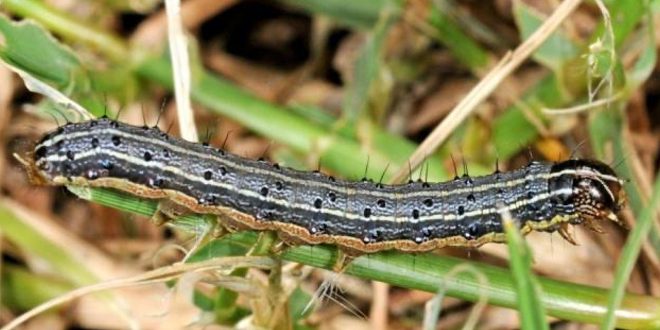(West Lafayette, IN) - It’s not too late for farmers to protect their crops or limit the damage from what’s described as an unprecedented invasion by fall armyworms.
Reports of fall armyworms in cumbersome numbers have come from states as far north as Kentucky, Indiana, Ohio, and Michigan. The species migrates from the south, where they thrive in the warmer climate, but their late summer numbers to the north this year are extreme.
“We’ve not seen anything like this before,” said Christian Krupke, a field crop entomologist at Purdue University.
Krupke said the fall armyworm likes to eat the leaves on many kinds of vegetation but prefer young plants leaving crops like hay and late-planted soybeans especially vulnerable. Once the leaves are gone, the plants can no longer generate the energy from the sun they need to survive.
Depending on density and size, Fall armyworms can decimate a field practically overnight before marching in a group to the next and closest food source. Armyworms begin as larvae and turn into caterpillars before going underground to transform into moths.
Signs of a bumper crop in the Midwest emerged about a month ago when fall armyworm moths in large numbers were detected coming up from Kentucky. In response, Purdue University issued an advisory to farmers to scout for the predators in their fields.
Armyworms also like many types of grass and other plants such as alfalfa, corn, beets, cabbage, and onions. However, late-planted crops like corn and soybeans are too mature this time of year to attract many species, and not every grower of still young plants will be impacted.
However, Krupke said the chances of infestation are “decent,” and producers especially vulnerable to the species right now should pay close attention to their fields.
“Anyone that is growing forage, particularly alfalfa, would be prudent to have a look,” he said.
An insecticide applied at dusk or dawn is very effective in killing armyworms while they’re young. Controlling them is more difficult as they become larger and more resistant to the chemicals, though.
The Midwest invasion is already easing up in the more southern areas. Krupke expects the threat further north to start diminishing in mid-September when the species, after reaching maximum growth, burrows into the soil to become a moth. The threat is further reduced as more hay gets brought in from the fields reducing a significant food source for the species.
Krupke believes another wave in the fall is likely from the next crop of moths coming up from the ground depositing larvae. However, the fall armyworm numbers won’t be nearly as significant because the food supply is further reduced and other factors like cooler weather in subtropical species.
Krupke could not point to a specific cause with certainty to explain the much higher numbers in this part of the country. He believes the boom might have something to do with the direction of the wind patterns, though, after rising above the surface as moths.
“A lot of their flight is passive. In other words, they get up in the Jetstream and land where they land,” Krupke said.
According to researchers at Ohio State University, fall armyworm caterpillars vary in color from greenish to tan to dark brown with stripes along the body. Therefore, an appropriate identifier is an inverted white “Y” shape behind the head.





